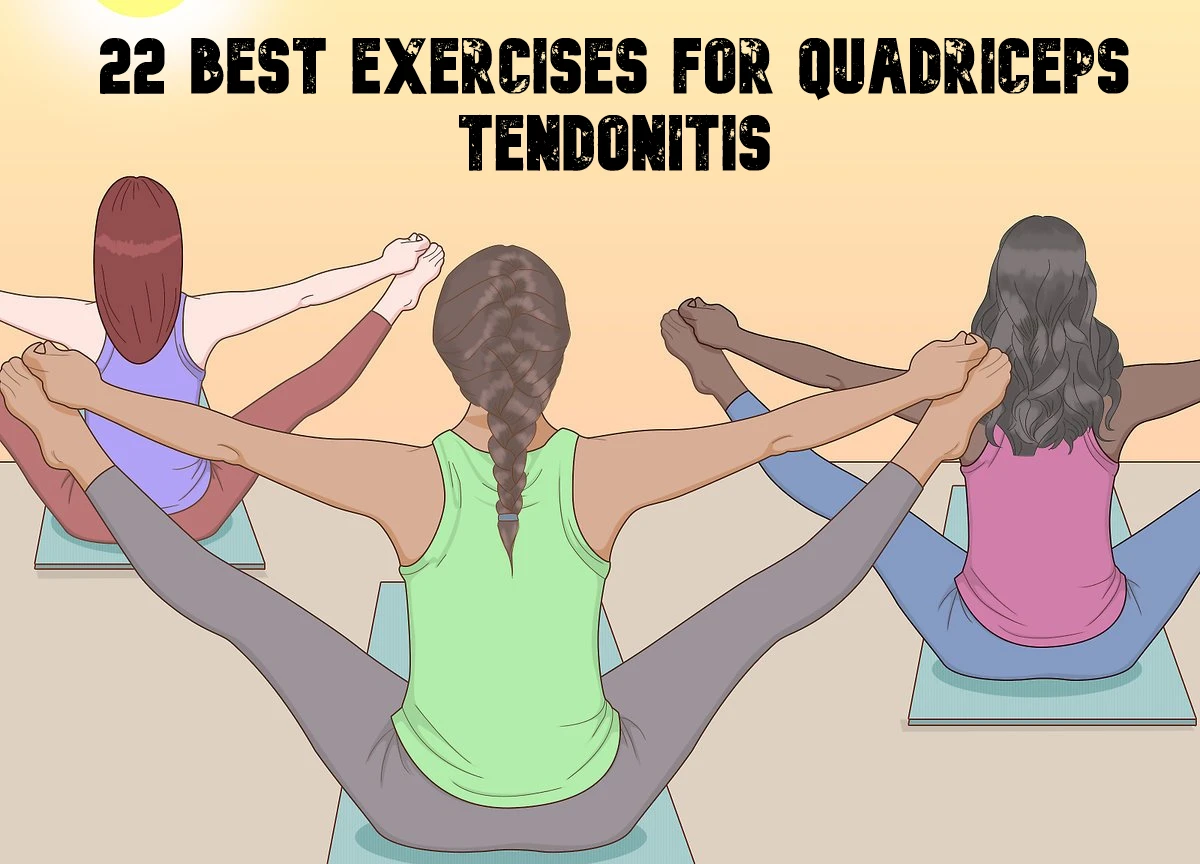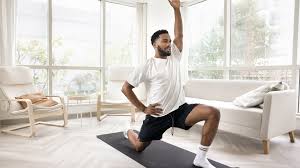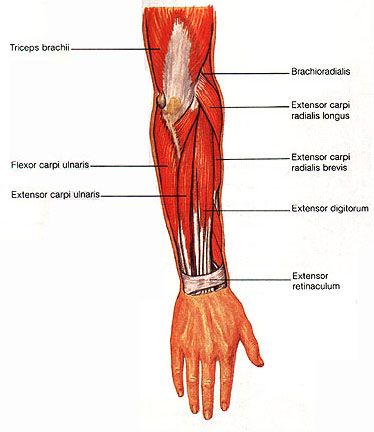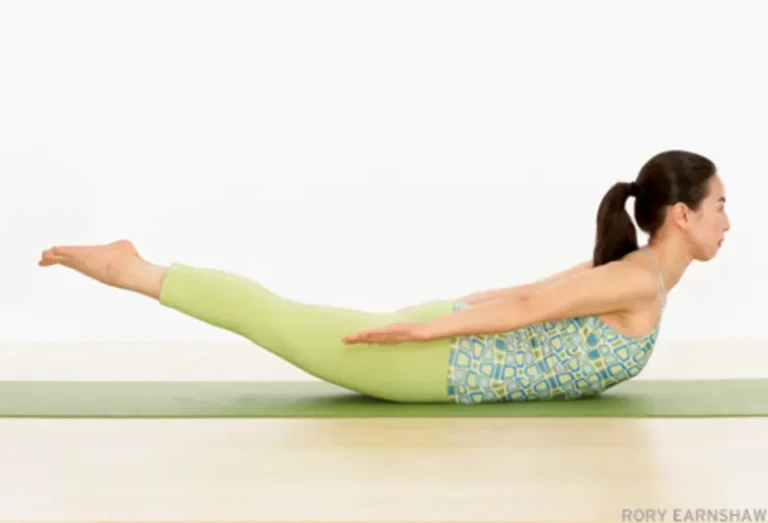22 Best Exercises For Quadriceps Tendonitis
Table of Contents
Introduction
Quadriceps tendonitis, characterized by inflammation of the quadriceps tendon that connects the quadriceps muscles to the patella (kneecap), can be a challenging condition to manage.
Exercise plays a crucial role in rehabilitation by promoting strength, flexibility, and overall joint stability. However, it’s essential to approach exercises cautiously to avoid exacerbating the condition.
In this guide, we will explore some of the best exercises for quadriceps tendonitis, focusing on activities that help alleviate symptoms, improve strength, and support the healing process.
Leg presses, leg extensions, weighted squats, lunges, and hack squats are some exercises that help with quadriceps tendonitis. In general, single-leg workouts are preferred to double-leg workouts. Other therapies are frequently used to help when basic treatments are ineffective.
Related Anatomy
- Your quadriceps muscles are connected to your kneecap (patella) by the quadriceps tendon.
- It functions to straighten your knee, facilitating stair climbing, walking, and jumping.
- It is known as quadriceps tendinitis or quadriceps tendinopathy if the tendon becomes inflamed.
- Tendonitis is another spelling for it.
- It often occurs as a result of repetitive motions like kneeling or jumping.
- Tiny tears from this misuse result in pain and swelling.
- Professionals are frequently affected by the injury, including volleyball and basketball players.
- All athletes, though, are susceptible to quadriceps tendinitis. If you abruptly increase your physical activity, the danger increases.
What are the quadriceps muscles?
4 front thigh muscles make up the quadriceps. They come together to form a tendon that inserts into the patella, or kneecap. The patella and shin bone are connected through the patella tendon.
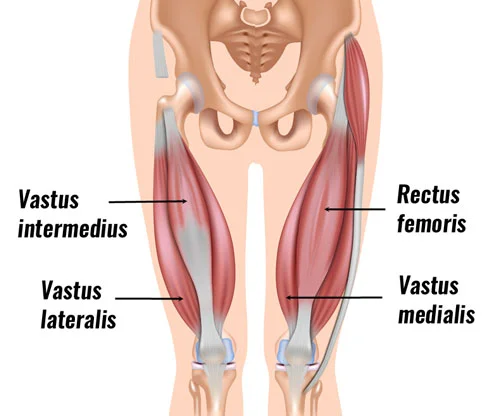
High on the thigh bone is where the vastus medilis, vastus intermedius, and vastus lateralis begin. They therefore cross one joint, the knee. The rectus femoris crosses both the hip and the knee since it begins on the front of the hip on the pelvis.
Exercises for Quadriceps Tendinitis
Stretches
They may develop quadriceps tendinitis as a result of tight muscles that impair their range of motion. If you have this problem, you should stretch the quadriceps, hamstrings, and calf muscles. Repeat three times, holding each stretch position for 20 to 30 seconds. If you use the right method, there should be a powerful pull but no pain.
Quadriceps Stretch
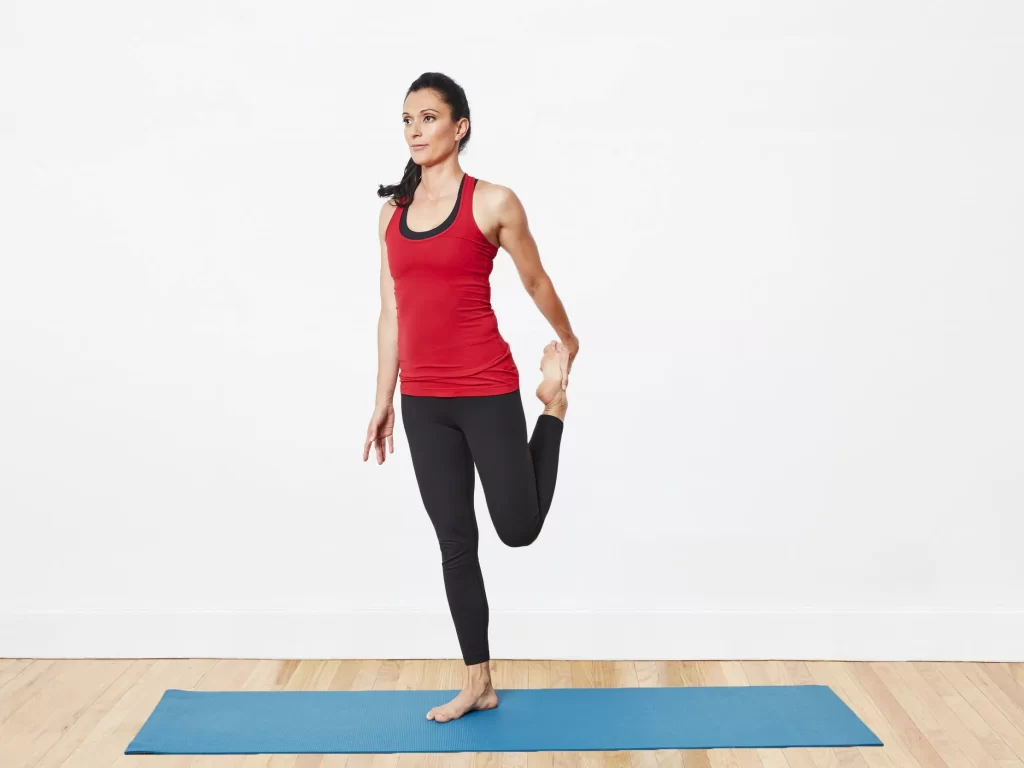
Place your feet shoulder-width apart as you stand. Retrace your left leg by around three feet. Place your left knee on the floor while bending both of your knees. Move your weight forward onto the front leg and maintain your straight frame until you feel a stretch in the front of your left hip.
Bend at the left knee, reach back with your left hand, and grip your left foot, take this position. At this point, you should feel a stretch from your hip to your knee along the front of your leg. On the other leg, repeat.
Hamstring Stretch
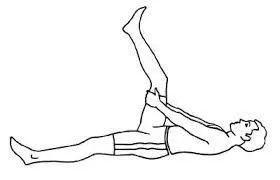
Place your feet shoulder-width apart as you stand. Step your right leg straight out in front of you, resting on your heel, while bending your left knee. Bend forward at the hips and maintain your right knee straight until you feel a powerful tug down the back of your thigh. To make this stretch more difficult, bring your toes up towards the ceiling.
Calf Stretch
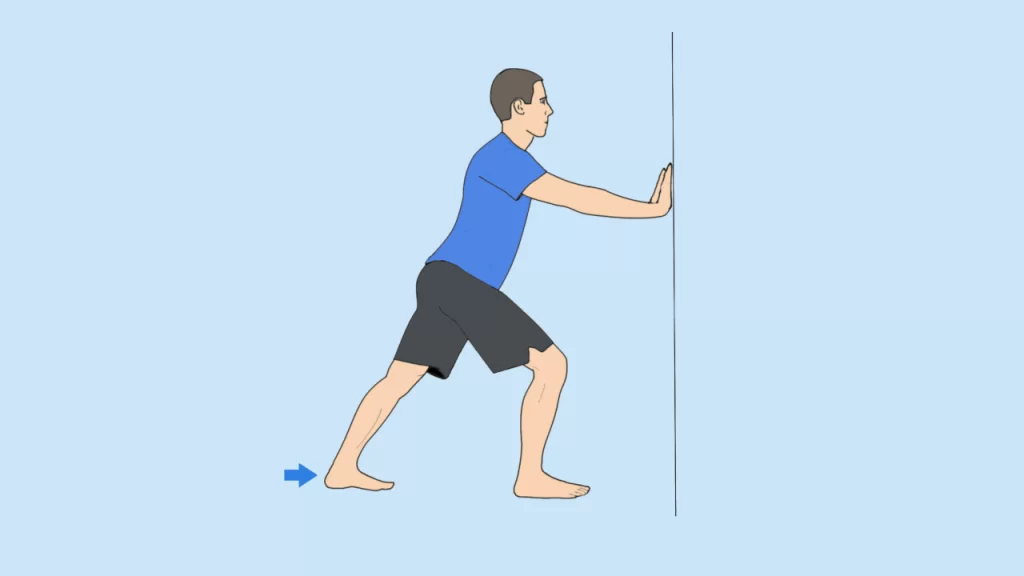
Put your hands at chest height up against a wall. Follow your right leg by around three feet. Bend the left knee. Lean forward and maintain a straight right knee until you feel a powerful pull at the back of your calf. To target different calf muscles, experiment with altering this stretch by slightly bending the back knee.
Strengthening
You might experience quadriceps weakness if your normal activities have been limited by tendinitis. Your pain might get worse if the healing process strengthens too soon. Once you can walk around pain-free or as directed by your healthcare provider, start strengthening activities.
Step-ups
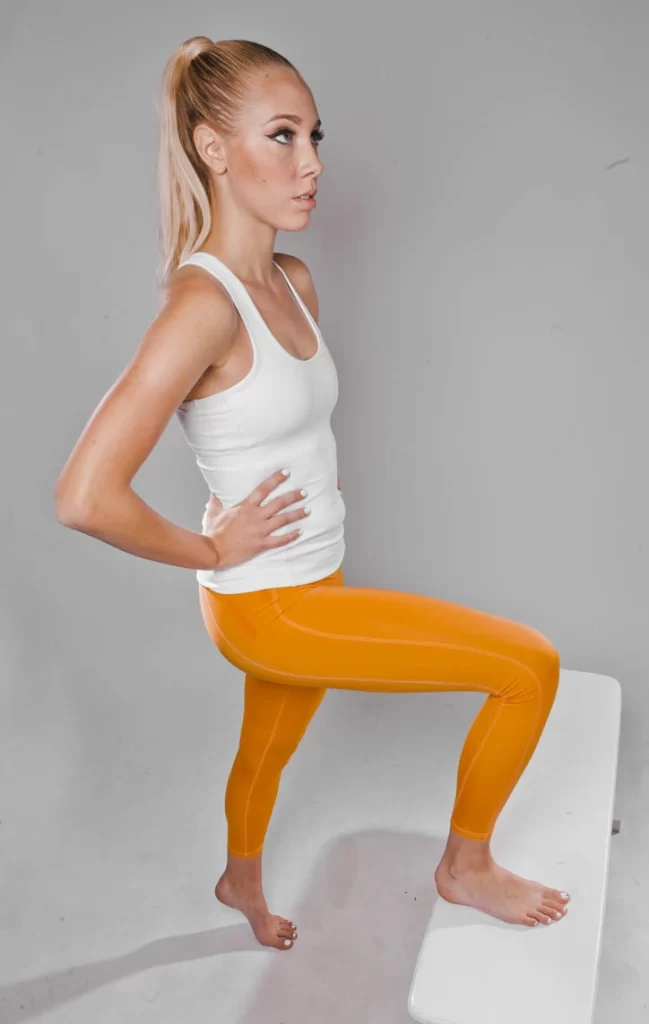
Step up using a short box at first (four inches, for example), then increase the size to 12 inches as your strength improves. Take a forward step with your weak leg onto the box. While standing on the box, fully extend your knee. Step off the box early, stepping backward with your uninjured leg.
Once you’ve performed this exercise a few times, use the damaged leg to lower yourself as you step off the front of the box. The quadriceps muscle is further worked by this exercise. In addition, perform lateral step-ups by leading with the damaged leg and stepping sideways onto the box. Step up 10 times straight, working in sets of 3.
Squats
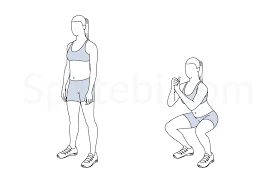
Squats should be done early on with your back against a wall. Step your feet out in front of you, roughly 2 feet, while leaning against a wall. Once your thighs are parallel to the floor, bend your knees and slide down the wall. After one or two seconds of holding, get back up. Perform three sets of 10 repetitions or more.
To advance with this workout, try doing squats without using the wall as assistance. Squat down farther so that your butt is below your hips as your strength increases.
Flex your hip flexors and quadriceps
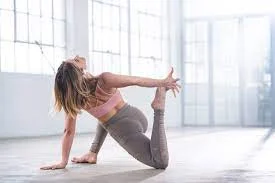
With your right leg flat on the ground and your hand supporting your head, lie on your side.
Bend your upper leg, then follow through with your other hand to hold the front of that foot or ankle.
Drag your foot in the direction of your buttocks to extend your leg back. Feel your front thigh getting stretched. This stretch should not be performed if it puts strain on your knee. Hold the pose for a minimum of 15 to 30 seconds. Do this two or four times.
Leg Laterally Rotated
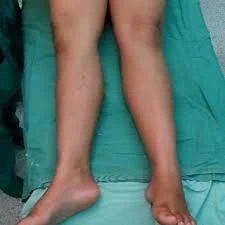
Lift your leg so that it resembles a bent leg. Avoid hunching your back. Maintain an active abdominis. You may also try doing this while putting your toes straight up in the air. An ankle weight could also be added to raise the test difficulty.
Perform two sets of 15 reps for each leg once every day. (Once you can complete this exercise effectively for 30 repetitions or more, stop and resume the other sports.)
Bridge Exercise with Straight Leg Raise
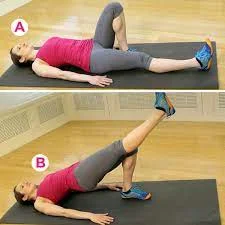
As you lift your buttocks, hips, and pelvis into the air, maintain your pelvis level. Take a moment to elevate your leg. Hold for between three and five seconds, then lower the leg back to the ground and repeat with the other leg.
When you are unable to keep your pelvis from wobbling or your buttocks from falling, return them to the ground and rest. Show off both legs. Once a day, perform 2 sets of 10 repetitions for each leg.
Wall Squat
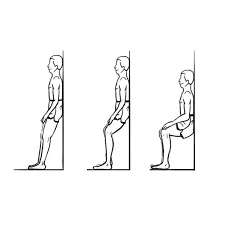
Place your head, back, and pelvis against a wall while standing. Your feet should be sufficiently away from the wall and around hip-width apart. Your knees will form a 90-degree angle as you glide down. As long as you can see your toes, make sure your knees follow your feet. To ensure that your knees are properly aligned, try to have them track towards your second toe.
Lower your body slowly from the beginning posture and keep it there for a while. Improve the length of time you hold the wall squat as you get better. Maintaining your head, back, and pelvis against the wall requires confidence. Don’t let the motion hurt. (An alternative to enhance VMO activation is to compress a ball between your knees while you work out. Normally, the diameter of the ball would be around 12 inches.) Hold for 15 to 20 seconds three times a day.
Wall Squat with Leg Raise
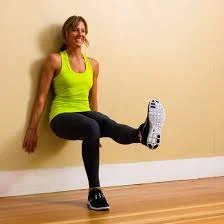
Lower your body slowly from your starting position and keep it there for a while. Spread your knees apart. First, hold for three to five seconds. Increase the time you maintain the wall squat and knee-raising stance as you get better.
Ensure your head, back, and pelvis are all against the wall. Don’t let the motion hurt. Once a day, perform two sets of ten repetitions. Increase the time spent on each rep to 10 to 15 seconds.
Plank Exercise Raise

Keep your chin tucked in so that your face is facing the floor. Your back muscles, stomach, buttocks, and thighs are all in on this. Under the shoulders, elbows should be straight. Do not slouch; maintain an upright posture. Once a day, complete two sets of 30 to 60 seconds.
Thigh strengthening exercises
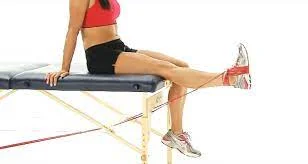
The muscle typically pulls up following an injury to control future damage and protect the original injury. While this could be helpful in the beginning, if left unchecked, it might hinder the production of sport and increase your vulnerability to further harm. Before attempting any self-help, we advise consulting a professional.
Active range of motion exercises
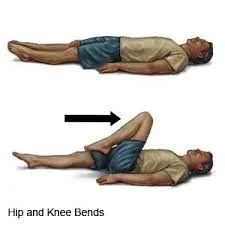
When movement is especially limited in the early phases of rehabilitation, this activity is beneficial. Only move the knee through its whole, pain-free range of motion.
This can be done in three different positions: sitting, standing, and lying down. Avoid taking on too much too quickly. If something hurts, get away from it. At least 3 times a day, complete 10 sets at a time.
Static quadriceps stretch
This means that you can accomplish this either by lying on your front or by standing up. Till the front of your thigh feels a little stretched, pull the foot of the affected leg towards the direction of your buttock. To enhance the stretch, raise your hips back. After holding this posture for 20 to 30 seconds, repeat this 3 times. Do this three times a day at the very least.
Passive quadriceps stretch
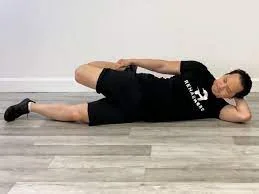
This has to do with exerting some force outward to aid in muscular stretching. It is not necessary to perform both the static quad stretch overhead and this stretch! A wall can be used by bending back onto the foot after flexing the knee while standing in front of it.
Alternatively, you might have a companion push your leg while you’re lying down. Additionally, hold for 20 to 30 seconds, then repeat three times, a minimum of three times a day.
Hip flexor stretch
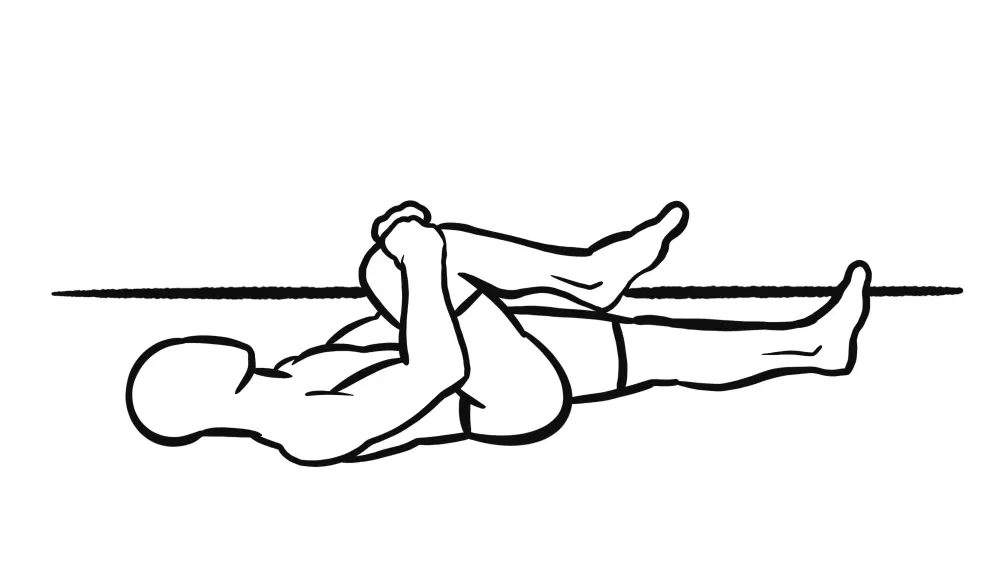
This stretch will focus on strengthening the muscles of the rectus femoris and Iliopsoas. Kneed with one knee on the ground and the other foot extended to reveal your knee propensity.
Keep your back straight and forward your hips.
Both the top of the thigh and the front of the hip should feel stretched. Hold for 20 to 30 seconds, then repeat three times, a minimum of three times a day.
Isometric quadriceps contractions

It is possible to start using static contractions quite early in the healing process. Their concern is to contract the muscle without causing the leg to move. You can perform this while standing or while posing with your legs straight out. For 10 seconds at a time, keep up the contractions.
Take a 5-second break before repeating, then do 10 repetitions.
Increase sets to two or three sets of 10 repetitions as your strength improves. Even while this workout is demanding, it will maintain muscle mass and help you return to optimal fitness more quickly. Work on this exercise daily until you can perform the concentric exercises listed below.
Straight leg raise
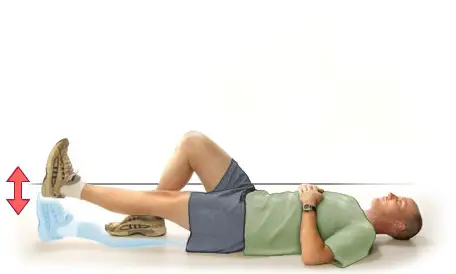
You can perform this exercise while sitting or while lying down. It’s more comfortable to lie down. Place your legs straight out in front of you while you sit flat on the ground. While keeping the knee straight, raise one leg off the ground. Hold for three to five seconds, then return to the starting position. Repeat 10 to 20 times.
You can complete this task every day. Increase the amount of reps and hold times to progress the exercise. The situation can be improved by adding ankle importance.
Knee extensions
The quadriceps are responsible for knee flexion and extension. An antagonist machine, an opposition band, an ankle weight, or no weight can all be used to complete this exercise. Begin with no weight and progress to an opposing band or ankle weights.
Once the knee is straight, carefully return to the starting position. Start with two sets of ten repetitions, then gradually work your way up to three sets of fifteen, increasing the weight or resistance as needed.
Lunges
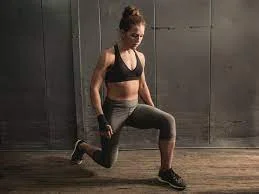
Sometimes referred to as split squats, lunges are a little simpler variation of the squat. Take a wide stance to begin. The rear knee should be bent, but not touching the floor. Remain upright with your back straight and avoid allowing your front knee to advance past your toes.
Perform two sets of ten repetitions with the injured leg in front of you, followed by two sets of ten with the affected leg behind you. Ascend gradually to 3 sets of 15. You can put a barbell over the shoulder or a dumbbell in each hand to make it more difficult.
Quadriceps tendinitis pain and other symptoms
Just above the top of the kneecap, on the front of the knee, is where quadriceps tendinitis hurts. Usually, the pain starts dull and gets worse with time. Prolonged sitting or prolonged leaping, crouching, or running may exacerbate the pain.
For other people, the discomfort may subside while they are moving but come back when they stop. Additional signs and symptoms consist of:
- stiffness, especially in the morning
- swelling
- tenderness
- weakness
- poor mobility
Quadriceps tendinitis causes
Excessive use is the most frequent cause of tendinitis in the quadriceps. Small tears result from the tendon moving in a particular way over and over. Your body normally strives to mend these tears. But additional tears will form if you keep making the same motion.
Quadriceps tendinitis can also result from repetitive motions such as:
- sports
- trauma, like jumping on a hard surface
- sudden increase in physical activity
- poor posture
- poor walking habits
Risk factors for quadriceps tendinitis
Quadriceps tendinitis can affect anyone who exercises regularly. However, athletes are more at danger, particularly if they:
- run on hard surfaces
- play jumping sports, like volleyball and basketball
- exercise without warming up
- exercise without enough recovery time
- repeatedly squat or kneel
Additional elements that raise your risk are as follows:
- Age. The tendons grow less flexible and more prone to irritation as you age.
- Weight. The tendons undergo extra strain when one is overweight.
- Tight muscles. Tendon pressure increases in your body by tensing the quadriceps and hamstrings.
- Chronic disease. Diabetes and psoriasis are two conditions that lower knee blood supply. Tendinitis is more likely as a result of the tendons getting stronger.
- Alignment problems. One leg will be under greater strain if your bones or joints aren’t lined up correctly. A comparable effect can be caused by muscular imbalances.
Diagnosing quadriceps tendinitis
Your physician will diagnose quadriceps tendinitis using a variety of tests. This could consist of:
- Physical exam. Your doctor will perform a physical examination of your knee and its surrounding tissues during your session. They will assess for discomfort, swelling, and soreness.
- Medical history. This aids in your doctor’s understanding of the possible cause of the damage.
- Imaging tests. You might need an ultrasound or MRI. Your knee tendons are captured in great detail by these examinations.
Quadriceps tendinitis treatment
Your doctor will design a customized treatment plan once they have assessed the extent of your damage. Treatment typically entails a mix of techniques.
Nonsurgical treatment
Usually, treatment begins with conservative measures. This calls for non-surgical interventions.
RICE
RICE is the first-line treatment for tendinitis of the quadriceps. This medical intervention includes:
- Rest. You have to limit activities that put excessive stress on your knees to protect the affected area. To stabilize your knee, you might require a brace to help.
- Ice. Swelling and pain can be decreased by applying ice or a cold compress.
- Compression. Moreover, a bandage with compression will reduce swelling.
- Elevation. Placing your harmed knee on an elevated surface will help to further reduce swelling.
Physical therapy
After the swelling subsides, your physician could advise you to see a physical therapist. They are able to offer therapies such as:
- massage therapy
- hot and cold treatments
- ultrasound (sound wave) therapy
- personalized exercise program
Quadriceps tendinitis exercises
You can learn how to perform exercises for quadriceps tendinitis safely from a physiotherapist. Your knee tendons are supported by your hips and hamstrings, which are strengthened by these activities. They also contain exercises to improve the surrounding muscles and quadriceps tendon’s suppleness.
Quadriceps tendinitis taping and bracing
A physical therapist or physiotherapist may wrap your knee with athletic tape to relieve some of the strain on your tendon. By stabilizing the kneecap, taping helps to relieve knee pain. A knee brace is an additional choice that might relieve some of the strain on your tendon.
Orthotics
Footwear with inserts that assist the foot are called orthotic devices. By lessening the strain on your knee tendons, they aid in the treatment of tendinitis. Your doctor might suggest a store-bought or custom-made orthotic insert, depending on your symptoms.
Anti-inflammatory medications
NSAIDs, or nonsteroidal anti-inflammatory medicines, are over-the-counter analgesics. The following NSAIDs can be used to relieve tendinitis pain:
- ibuprofen
- naproxen
- aspirin
Consult your physician to find out if taking NSAIDs is appropriate for you. Acetaminophen may be recommended by your doctor in place of an NSAID. Injections of local corticosteroids into your knee may also be recommended by your physician.
Quadriceps tendon surgical repair
Most patients with tendinitis in their quadriceps don’t require surgery. However, surgical repair may be necessary if nonsurgical treatments prove ineffective or if your injury is severe. Your tendon’s injured section will be removed by the surgeon during surgery. The following operations are included in the surgical options:
- One sizable incision is made during open surgery.
- Mini surgical instruments, a tiny video camera, and tiny incisions are used in arthroscopic surgery. Open surgery is more invasive than this.
- Ultrasonic energy is used in percutaneous ultrasonic tendon debridement to remove injured tissue.
Recovery and outlook
Recovery from quadriceps tendinitis is influenced by a number of variables, such as your:
- age
- overall health
- severity of injury
- treatment plan
Mild tendinitis often heals in a few weeks with treatment that is not surgical. At this stage, you can gradually resume your physical activity. Nevertheless, it may take six to twelve weeks to feel better if the injury has been present for some time.
Recovery from surgery could take six to nine months. Weight-bearing exercises must be avoided for the first six weeks. When your range of motion increases, you can gradually begin strengthening activities. After seven months, you ought to be ready to gradually resume your athletic endeavors.
Conclusion
Although quadriceps tendinitis can affect anyone, athletes are more susceptible. Jumping, running, and squatting all involve repetitive motions that might irritate the quadriceps tendon. Usually, quadriceps tendinitis resolves in a few weeks. Get plenty of rest and adhere to a physical therapist’s advice for optimal outcomes.
FAQ
In order to treat quadriceps tendinitis, the joint must be rested and iced, painful activities must be avoided, and over-the-counter anti-inflammatory medications must be taken as needed. Exercises from physical therapy may also be recommended by your doctor to strengthen and stretch your legs.
Just above the kneecap, on the front of the knee, is where quadriceps tendinitis hurts. Usually, the pain starts out dull and gets worse with time. Prolonged sitting or prolonged leaping, crouching, or running may exacerbate the pain.
If your quad tendinitis is not bothering you, you can still walk. The limping stances can start to hurt other parts of your body, such as your hips and lower back if you try to walk through any pain.
Long-term scar tissue accumulation in the event of chronic quadriceps tendinitis increases the risk of re-injury to both the tendon and the knee joint as a whole. Risk factors for quadriceps tendinitis include: engaging in “jumping” activities like volleyball, basketball, and running.
A good two to three weeks of rest are usually necessary for mild tendinitis. You’re looking at anywhere from three months to six weeks for more serious damage. However, you might require a lot more time than that. Resolving some cases of tendinopathy may take up to a year.
References:
- Bailey, A. (2010, July 9). Exercises for Quadriceps Tendinitis. LIVESTRONG.COM. https://www.livestrong.com/article/169625-exercises-for-quadriceps-tendonitis/
- Nunez, K. (2019, December 10). Causes and Treatments for Quadriceps Tendinitis. Healthline. https://www.healthline.com/health/quadriceps-tendonitis#outlook
- Walden, M. (2022, November 8). Quadriceps Tendinopathy Exercises. Sportsinjuryclinic.net. https://www.sportsinjuryclinic.net/sport-injuries/knee-pain/anterior-knee-pain/quadriceps-tendonitis-exercises
- Rupapara, D. (2023, December 13). Quadriceps Muscle strain – Cause, Symptoms, Treatment, Exercise. Mobile Physiotherapy Clinic. https://mobilephysiotherapyclinic.in/quadriceps-muscle-strain/

